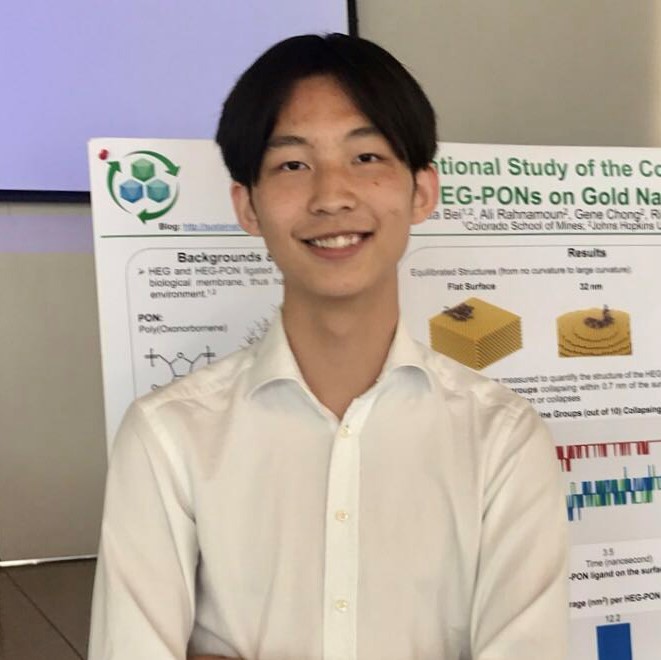Computer science in chemical engineering:
AnDY Bei talks interdisciplinary experience in undergraduate Research
By Erika Stromerson / 2019

Engaging in research as an undergraduate can be daunting. Ronghua Bei, who goes by Andy, took daunting to a whole new level as his research took a new direction into the interdisciplinary this past spring.
His research professor, Dr. Joseph Samaniuk, decided to add a computational component to his ongoing research with 2D materials at fluid interfaces. These materials consist of only one layer of atoms across their entire surface, making them as close to truly two-dimensional ascan be found in nature. Andy began teaching himself MatLab and Python to help Samaniuk see this element through by building interface simulations.
“I’m closer to a Comp Sci than a ChemE,” Andy jokes.
The junior in chemical engineering started researching with Samaniuk his freshman year. At the time, he didn’t know if research was really for him.
Wherever it goes, I’m responsible for that.
He got a better sense of what research Mines had available simply through Googling professors’ work, and sending emails to the ones he saw as potential mentors. Samaniuk replied, met with Andy, and together they set up a plan for Andy to get involved in his research.
He now works in Samaniuk’s lab to study capillary interactions between two-dimensional materials, graphene, at fluid-fluid interface. Currently, he works with graduate student David Goggin to develop computational simulations of the experiments David creates. It took a great deal of trial and error to get his simulations up to par.
He shows a simulation he built of a water molecule interacting with a 2D graphene layer. “If I do something wrong, it’s very hard to tell I did something wrong,” Andy explains. “If you do experimental science, whatever you see [is valid]. If you do simulation experiments, whatever you see may or may not be, because it all depends on the inputs you put into it. It’s not just about interpretation, it’s how you prepare the simulation too.”
Andy had to find a way to check his coding for consistency, since he’d never coded before starting research. He calibrated his simulations by building simulations from published papers and testing his results against those results, gradually tweaking code to get more and more
precise with time.
It took him a full year to build the ultimately successful codes.
Andy is both excited and nervous about taking the initiative on this new element to his research. “Wherever it goes, I’m responsible for that,” he says.
It’s about exploring the unknown, because who knows what you can make out of it.
His new expertise in computational simulation has gained notice in the research community. This past summer, he had the opportunity to participate in another computational research project at Johns Hopkins, and tour labs around the country, supported by the Center for Sustainable Nanotechnology (CSN-REU). His plan for this upcoming summer is to apply his simulation skills in the industry through internship. He believes, no matter the direction he takes, it’s ultimately about independent problem-solving.
But he couldn’t have gotten this far without developing a passion for undergraduate research, which is still growing. This is his third year receiving funding from the Mines Undergraduate Research Fellowship (MURF) to continue doing what he loves.
“When I was first doing research I was very afraid of getting nothing out of it,” says Andy. “If it is a problem out of a textbook, you know it’s gonna be A, B, C, D — it’s one choice out of those four. It’s not gonna be E, but in research, it’s beyond A, B,C, D. It’s E to Z, and who knows past that. The ambiguity really teaches me, at least, how real life may or may not have a definite answer.”
But beyond the internship prospects and extracurricular enrichment, Andy is inspired by the
sheer potential research offers.
“It’s about exploring the unknown, because who knows what you can make out of it,” he says. “You can make nothing out of it, who knows! It’s very possible.”
Andy knows firsthand how daunting the prospect of starting research is, especially when that research requires elements far outside your own area of expertise. But he’s hopeful that with perseverance, anything is possible with it. His advice: give research a try. There’s no loss if you don’t enjoy it, and if you do it’s all the better. The trick is to persevere.
It’s simple, according to Andy: “teach yourself programming, and essentially explore the unknown.”
He has the first one down. Now that his research has gone interdisciplinary, he has even more tools to explore the daunting, exciting unknown.
